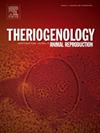两种阴道内黄体酮释放装置在泌乳荷斯坦奶牛中的应用比较,同步采用基于 5 天 GnRH 的定时人工授精方案
摘要
这项研究的目的是比较CIDR与PRID-Delta装置在泌乳荷斯坦奶牛TAI的5天发情同步方案中的使用效果,这些奶牛要么在自愿等待期结束后未发情,要么在上次人工授精后未怀孕且未恢复发情。对安装了颈圈式自动活动监测系统(Alta Cow Watch)的奶牛实施标准的 5 天卵巢同步方案[第 0 天注射 100 μg 促性腺激素(GnRH),第 5 天和第 6 天注射 500 μg 氯前列醇],并随机分配在第 0 天和第 5 天之间接受含有 1.35 g(CIDR;n = 304)或 1.55 g(PRID ® DELTA;n = 304)黄体酮的阴道内装置。所有奶牛在阴道内装置取出约 56 小时后接受第二次 GnRH 给药,72 小时后接受定时人工授精 (TAI)。人工授精采用常规冷冻解冻精液。记录TAI前的发情事件,并在第0天、TAI后33天和61天分别进行经直肠超声波检查,以确定是否存在黄体(CL),从而诊断和确认妊娠。登记时,奶牛平均泌乳 2.2 次,产奶 124.3 天,产奶量 43.6 千克/天。在开始治疗时,有CL的奶牛总比例为68.8%,不同治疗组之间没有差异。与无CL的奶牛相比,有CL的奶牛在TAI后33天和61天的每次人工授精受孕率(P/AI)更高(P < 0.01;分别为46.9%和42.3% vs. 32.1%和27.4%)。在TAI前表示发情的奶牛总比例为24.8%,各处理组之间没有差异;但是,在TAI前表示发情会影响TAI后33天和61天的P/AI(P <0.01;表示或不表示发情的奶牛的P/AI分别为53.6%和49.0%,而不表示发情的奶牛的P/AI分别为38.5%和33.9%)。在TAI后33 d,PRID组和CIDR组每次人工授精的妊娠率往往因处理组而异(P = 0.08;PRID组和CIDR组分别为46.1%和38.5%),PRID处理的奶牛(43.8%)与CIDR处理的奶牛(31.6%)相比,在TAI后61 d的P/AI更高(P <0.01)。因此,经 PRID 治疗的奶牛的妊娠损失低于经 CIDR 治疗的奶牛(P < 0.01; 5.0 vs. 17.9 %)。此外,PRID 处理(P = 0.08)往往会减少双胎妊娠(PRID 和 CIDR 处理奶牛的双胎妊娠率分别为 7.9% 和 14.5%)。总之,与采用5天卵巢同步TAI方案加CIDR的奶牛相比,采用5天卵巢同步TAI方案加PRID-Delta的泌乳奶牛在TAI后61天的P/AI更高,TAI后33至61天的妊娠损失更低,双胎妊娠更少。The objective of the study was to compare the effectiveness of CIDR vs. PRID-Delta devices for use in a 5-day Ovsynch protocol for TAI in lactating Holstein cows that were either not in estrus after the end of the voluntary waiting period or non-pregnant and not returning to estrus following the previous AI. Cows fitted with a collar-mounted automated activity monitoring system (Alta Cow Watch) were subjected to a standard 5-d Ovsynch protocol [100 μg of gonadorelin (GnRH) on Day 0 and 500 μg of cloprostenol on Days 5 and 6] and allocated randomly to receive either an intravaginal device containing 1.35 g (CIDR; n = 304) or 1.55 g (PRID ® DELTA; n = 304) of progesterone between Day 0 and 5. All cows received a second administration of GnRH at approximately 56 h and timed-AI (TAI) 72 h after intravaginal device removal. Inseminations were done using conventional frozen-thawed semen. Estrus events prior to TAI were recorded and transrectal ultrasonography was done on Day 0 to determine presence of a corpus luteum (CL) and 33 and 61 d post-TAI, respectively, to diagnose and confirm pregnancy. Cows had an average of 2.2 lactations, 124.3 days in milk, and a milk yield of 43.6 kg/d at enrollment. The overall percentage of cows with a CL at initiation of treatment was 68.8 % and did not differ between treatment groups. Cows with a CL had greater pregnancy per AI (P/AI) at 33 and 61 d post-TAI than cows without a CL (P < 0.01; 46.9 and 42.3 % vs. 32.1 and 27.4 %, respectively). The overall percentage of cows that expressed estrus prior to TAI was 24.8 % and did not differ between treatment groups; however, estrus expression prior to TAI affected P/AI at 33 and 61 d post-TAI (P < 0.01; 53.6 and 49.0 % vs. 38.5 and 33.9 % for those expressing or not expressing estrus, respectively). Pregnancy per AI at 33 d post-TAI tended to differ between treatment groups (P = 0.08; 46.1 vs. 38.5 % for PRID and CIDR groups, respectively) and P/AI at 61 d post-TAI was greater (P < 0.01) for PRID-treated cows (43.8 %) compared to CIDR-treated cows (31.6 %). Thus, PRID-treated cows had lower pregnancy loss than CIDR-treated cows (P < 0.01; 5.0 vs. 17.9 %). Also, treatment with a PRID tended (P = 0.08) to result in fewer twin pregnancies (7.9 vs. 14.5 % for PRID and CIDR treated cows, respectively). In conclusion, lactating dairy cows subjected to a 5-d Ovsynch TAI protocol plus a PRID-Delta had greater P/AI at 61 d post-TAI, lower pregnancy loss between 33 and 61 d post-TAI, and fewer twin pregnancies compared to cows subjected to a 5-d Ovsynch protocol plus a CIDR.

 求助内容:
求助内容: 应助结果提醒方式:
应助结果提醒方式:


